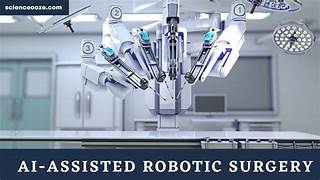AI in Surgical Robots for Complex Medical Procedures
Artificial Intelligence (AI) has rapidly revolutionized various fields, with healthcare being one of the most impacted sectors. Among the numerous applications of AI in healthcare, its integration into surgical robots has sparked a significant transformation, particularly in performing complex medical procedures. These technologies combine the precision of robotics with the power of AI, providing surgeons with enhanced capabilities that result in better patient outcomes. In this article, we will explore how AI is reshaping the landscape of surgery, the benefits it offers, the challenges it faces, and the future potential it holds in the field of complex medical procedures.
The Rise of Robotic Surgery
Robotic surgery is not a new concept. It has been in practice for several decades, but it has significantly evolved over time. Initially, robotic systems such as the da Vinci Surgical System allowed surgeons to perform minimally invasive procedures with greater precision, flexibility, and control than traditional methods. These robots provided a platform where surgeons could remotely control robotic arms to manipulate surgical instruments with greater accuracy than human hands alone. However, while these robotic systems were revolutionary, they still required human input for decision-making and lacked a significant amount of intelligence.
As AI technology progressed, it began to complement robotic surgery, bringing a new era of autonomy and precision to the field. By combining robotics with AI algorithms, surgical robots can now perform more complex tasks with enhanced accuracy, often minimizing human error and improving overall surgical outcomes.
How AI Enhances Surgical Robots
AI-powered surgical robots use advanced algorithms and machine learning techniques to process large amounts of data, make real-time decisions, and assist surgeons in performing complex tasks. The key areas in which AI enhances surgical robots include:
- Enhanced Precision and Control: One of the most significant advantages of AI in surgical robots is the precision they offer. AI algorithms enable robots to make microscopic adjustments that human hands may not be capable of, such as tiny movements during delicate procedures. For instance, in neurosurgery, AI-enabled robots can assist surgeons in navigating complex brain structures with unparalleled accuracy, reducing the risk of damaging critical areas.
- Real-time Data Processing: Surgical robots equipped with AI can process real-time data from various sources, such as imaging systems, patient vital signs, and preoperative data. This data processing allows the robot to adapt to changes during surgery and provide valuable feedback to the surgeon. For example, if there are unexpected changes in the patient’s anatomy or condition, the AI system can instantly recognize these shifts and suggest adjustments to the surgical approach.
- Assisting with Decision-Making: AI in surgical robots can assist surgeons in making better decisions by analyzing patterns from vast medical databases. By comparing the current surgery to thousands of similar cases, AI can provide insights that may not be immediately apparent to the surgeon. For example, it may suggest an alternative surgical approach or warn the surgeon of potential risks based on historical data.
- Autonomous Surgery: While full autonomy in surgery is still a concept for the future, AI-driven robotic systems are already capable of performing certain procedures with minimal human intervention. For example, some robotic systems can automatically adjust the surgical instruments’ position based on real-time feedback, reducing the need for constant manual control. In the future, fully autonomous surgical robots could be deployed in specific scenarios where human input may not be essential, especially in routine procedures.
Benefits of AI-Integrated Surgical Robots
- Minimally Invasive Surgery: One of the most well-known advantages of robotic surgery is the ability to perform minimally invasive procedures. These surgeries require smaller incisions, reducing the patient’s recovery time, minimizing the risk of infection, and leaving smaller scars. AI improves these procedures by ensuring that robotic systems make the smallest and most precise incisions, which in turn leads to faster recovery times and less post-operative pain.
- Improved Patient Outcomes: The combination of AI and robotics allows for highly accurate surgeries, leading to improved patient outcomes. In complex surgeries, where even minor errors can lead to complications, AI-powered surgical robots reduce the risk of human error. With AI’s real-time data analysis and predictive capabilities, surgical robots can identify potential problems before they arise, improving the likelihood of a successful surgery.
- Reduced Fatigue for Surgeons: Performing complex surgeries can be physically and mentally exhausting for surgeons. Robotic systems with AI assistance reduce the strain on surgeons by automating certain tasks, such as maintaining the surgical instruments’ position. This reduction in fatigue allows surgeons to focus on more critical aspects of the surgery and reduces the risk of burnout.
- Training and Simulation: AI-powered surgical robots also play a key role in training the next generation of surgeons. With the ability to simulate complex surgeries, robotic systems can provide valuable hands-on experience in a controlled environment. Surgeons-in-training can practice surgeries, make decisions based on AI recommendations, and receive instant feedback on their performance, which accelerates their learning process.
- Cost Efficiency: While the initial investment in robotic surgery systems is high, they have the potential to reduce long-term healthcare costs. By improving the accuracy of surgeries, reducing complications, and shortening recovery times, AI-driven robotic systems can help healthcare facilities optimize their resources. The efficiency of these robots can lead to fewer postoperative complications, less hospital readmission, and better overall management of healthcare expenses.
Challenges and Limitations
Despite the numerous advantages, the integration of AI into surgical robots also comes with its own set of challenges and limitations.
- High Costs: One of the major barriers to the widespread adoption of AI-powered surgical robots is their high initial cost. While the long-term savings are evident, many healthcare institutions struggle with the upfront expense of acquiring and maintaining these sophisticated machines. Smaller hospitals and clinics may find it challenging to justify the investment, limiting access to such advanced technologies.
- Ethical Concerns: The increasing autonomy of AI-powered robots raises ethical questions about the role of machines in healthcare. Some argue that as robots become more capable of performing surgeries independently, there could be a shift in the surgeon-patient relationship. Questions about accountability, particularly in cases of malfunction or errors, remain unresolved. Ethical frameworks need to be developed to ensure that AI remains a tool for human enhancement rather than a replacement.
- Training and Integration: Surgeons must undergo extensive training to use AI-powered surgical robots effectively. The integration of AI into surgical systems requires a significant shift in how surgeries are conducted. Surgeons must be comfortable working with AI recommendations and understanding the decision-making processes of the robot. Furthermore, ensuring that the robot’s AI is continuously updated with the latest medical research and data is essential to maintaining its relevance and effectiveness.
- Security Concerns: As with any digital technology, AI-powered surgical robots are vulnerable to cyber threats. Hacking or malfunctioning of the robots could have disastrous consequences for patients. Ensuring the cybersecurity of these systems is crucial to protect both the medical institutions and the patients from harm.
The Future of AI in Robotic Surgery
The future of AI in robotic surgery is incredibly promising. As AI technology advances, it is expected that robots will become more autonomous, capable of performing even more complex surgeries with minimal human oversight. The integration of AI with other emerging technologies, such as 3D printing and augmented reality, will further enhance surgical capabilities. In addition, AI will continue to support personalized medicine, tailoring surgical approaches to each patient’s unique anatomy and medical history.
Furthermore, AI could facilitate remote surgeries, where surgeons could operate on patients located in different parts of the world. This technology could be especially beneficial in underserved regions where access to skilled surgeons is limited.
Conclusion
AI-driven surgical robots are at the forefront of revolutionizing complex medical procedures. The synergy between robotics and artificial intelligence offers enhanced precision, reduced human error, and improved patient outcomes. However, challenges such as high costs, ethical concerns, and security risks must be addressed to fully realize their potential. As technology continues to evolve, AI-powered robotic surgery will likely become an integral part of the healthcare system, providing patients with safer, more effective, and less invasive treatments. The future of surgery is undeniably intertwined with the advancement of AI, promising a new era of medical excellence.


